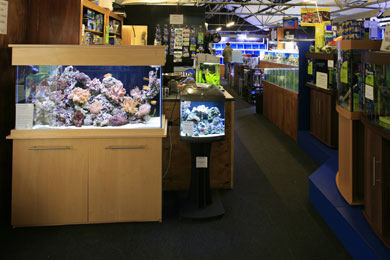
Always buy the biggest set-up you can afford. The term set-up, and not tank is mentioned because a large tank will need a large filter, large heater and adequate lighting, so make sure that you can afford not only the initial purchase price but also equipment costs and the costs of power to run it.
The actual tank should be as big as possible because larger volumes of water are more stable and at the end of the day our pet fish are captives, and the more room and exercise they receive, the happier they will be. The only restrictions are that once fish tanks reach 120cm/4’ and over they will weigh several hundred kilos when full, so need strong floors.
Tank height can also be a factor; generally speaking, don’t buy a tank deeper than your arm length as this will make maintenance difficult.
Modern engineering methods mean that any shape of aquarium is possible, but some are more suitable than others.
Surface area is still an issue even though aeration and filtration methods have become more advanced, and fish are adapted to swim horizontally more than vertically, so a suitable aquarium should reflect that.
This means that standard rectangles and bow-fronted aquariums are the most suitable as they have the largest surface area in relation to their volume and provide the maximum length for their inhabitants to swim in.
Very tall columns are the least suitable as maintenance is nearly impossible and, in the event of a power cut, a heavy fish stocking may suffocate due to a small surface area.
Spherical and cylindrical tanks distort the fish when viewing and hexagonal and octagonal tanks cut the viewing angle down. Corner tanks have pros and cons; they look good and are wide from front to back so can provide effective aquascaping, but are not very long so aren’t brilliant for territorial fish, and a small corner tank holds half the volume of a standard rectangle.
Aquarium types
Once you have decided on the size and shape of tank you can go out and do some shopping. You’ll usually find three basic types of aquarium available:
1. A basic glass tank, called an all-glass tank, or AGT for short. An AGT is fine but you must add on the costs of everything else to finish up with a functioning aquarium.
This includes lighting, filtration, water conditioners, thermometer, hood, cabinet or stand, coverglasses, test kits, heater and more. Buying all equipment and accessories separately can be the most expensive way of buying them, but at least you can get exactly the products you want in combination, regardless of manufacturer.
2. The set-ups. These are tanks and hoods that come with some equipment and accessories, and at a discounted price against their individual prices.
You will get a complete set-up cheaply from buying this way, and if you are unsure as to which equipment you need to get you started, the manufacturer will have taken care of that for you and some even come with a booklet on how to set the tank up.
Most also come with an additional deal if you buy the stand, and the only downsides are that manufacturers will only place their own products in these set-ups and retailers will be reluctant to swap and change. Very few come with everything that you need so you will have to buy test kits, a net, background paper and cleaning equipment, for example.
3. Systemised aquariums have the lighting and filtration fitted into the tank by the manufacturer. This takes the worry out of choosing and fitting equipment, but if you want to use different equipment or upgrade the lighting in the future, it isn’t always that easy. Make sure that the system is right for the sort of fish that you want to keep.
Some are perfect for tropical community and planted tanks but will need extra equipment if you wish to make them marine. Others are sold as dedicated marine systems with all the necessary equipment provided. In most cases you’ll still have to buy things like test kits, water conditioners and maintenance equipment. Shop around for systemised aquaria as selling prices vary a great deal.
Positioning
Place your tank where it’s easy to maintain and view. Try not to place it in natural sunlight as this may increase the water temperature and algal growth, too.
Keep it away from doors, which may slam, and also cause the fish distress from people traffic entering and leaving the room. Television will cause changes of light and noise and vibration, as will hi-fi speakers, which should never be placed on cabinets.
Place the tank next to power points but away from fires and radiators which can cause excessive heat. Lastly, if you buy a very large tank, make sure that you’re able to fit it through the front door!
Safety
All electrical appliances should really be plugged into a residual current device (RCD) which will cut out if something goes wrong, protecting you. RCDs are not just the domain of outside electricals.
Check that fuses are the correct size for the appliance – a 3 amp fuse is fine for most pumps and powerheads, and make a drip loop in electrical cables to stop any drips from entering the socket. Sockets should be just to the left or right of any cabinet, again so that they don’t catch any drips, and if using multi sockets in cabinets with sumps, consider using an outdoor weatherproof switchbox or sockets to increase your safety.



